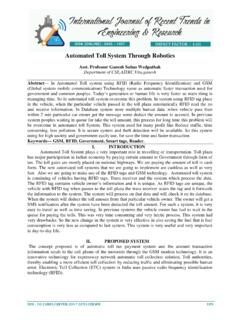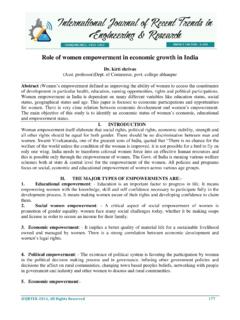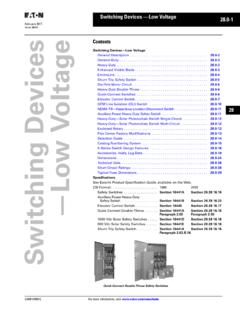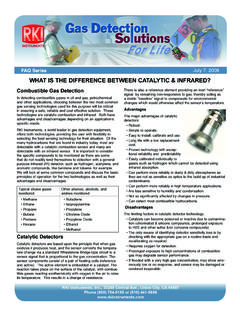Transcription of DESIGN AND ANALYSIS OF EXPANSION JOINTS AND BELLOWS
1 430 DESIGN AND ANALYSIS OF EXPANSION JOINTS AND BELLOWS , 1assistant Professor, Mechanical Department, Vels Institute Of Science, Technology And Advanced Studies, Pallavaram, Chennai-117 2assistant Professor, Mechanical Department, Velammal Engineering College, Velammal Nagar, Ambattur-Red Hills Road, Chennai - 600 066. Abstract: An EXPANSION JOINTS is an assembly designed to absorb the EXPANSION and contraction of various construction materials, to absorb vibration, or to allow movement due to ground settlement or earthquakes. An EXPANSION joint refers to a metal BELLOWS EXPANSION joint designed to absorb axial, lateral and angular motions in piping system.
2 The BELLOWS is the flexible element of the EXPANSION joint. It must be strong enough circumferentially to withstand the pressure and flexible enough longitudinally to accept the deflections for which it was designed, and as repetitively as necessary with a minimum resistance. This strength with flexibility is a unique DESIGN problem that is not often found in other components in industrial equipment. Since the BELLOWS must accept deflections repetitively, and deflections result in stresses, these stresses must be kept as low as possible so that the repeated deflections will not result in premature fatigue failures. In this project a metal EXPANSION joint along with the BELLOWS and the entire pipe cross over and the pressure parts in the cross over is designed by considering above words while designing.
3 In the cross over In line Pressure Balanced EXPANSION Joint is replaced instead of Single EXPANSION JOINTS and Elbow Pressure Balanced EXPANSION JOINTS is also present in the cross over. Pressure is applied in the cross over. DESIGN calculation is done manually. Then the DESIGN is modeled in the software Inventor. Then the model is imported by converting it in to STEP file format to the software Hyper Works. Finite Element ANALYSIS is continued in the software Hyper Mesh and the results are compared with the manual results. Based on the results, suggestions are given to the industry. I. INTRODUCTION An EXPANSION joint is simply a BELLOWS element with end connections. Regardless of accessories, such as liners and covers, it will deflect in any direction or plane that the BELLOWS will.
4 It is the least expensive type, but requires that the piping be controlled as to the direction of the movements required of the unit. The EXPANSION joint should not be expected to control the movement of the pipe. If the piping ANALYSIS shows that the EXPANSION joint must accept axial compression, then the piping must be guided and constrained so that only that movement will occur. This EXPANSION joint will not resist any deflections with any force other than the resistance of the BELLOWS , which is a function of the spring rate times the deflection amount. It is incapable of resisting the pressure thrust along its axis, which is the product of the pressure times the effective, or cross sectional, area of the BELLOWS . Large diameter units, even with low pressures, can generate very large axial pressure thrust forces, which must be reacted by main and directional anchors.
5 Otherwise the EXPANSION joint will extend with disastrous results. The BELLOWS is the flexible element of the EXPANSION joint. It must be strong enough circumferentially to withstand the pressure and flexible enough longitudinally to accept the deflections for which it was International Journal of Recent Trends in Engineering & Research (IJRTER) Volume 04, Issue 03; March- 2018 [ISSN: 2455-1457] @IJRTER-2018, All Rights Reserved 431 designed, and as repetitively as necessary with a minimum resistance. This strength with flexibility is a unique DESIGN problem that is not often found in other components in industrial equipment. Most engineered structures are designed to inhibit deflection when acted upon by outside forces. Since the BELLOWS must accept deflections repetitively, and deflections result in stresses, these stresses must be kept as low as possible so that the repeated deflections will not result in premature fatigue failures.
6 Reducing bending stress resulting from a given deflection is easily achieved by simply reducing the thickness of the bending member, which in the case of the BELLOWS , is the convolution. However, in order to withstand the pressure, the convolution, which is also a pressure vessel, must have a thickness great enough that the pressure induced membrane stresses are equal to or less than the allowable stress levels of the materials at the DESIGN temperatures. This conflicting need for thickness for pressure and thinness for flexibility is the unique DESIGN problem faced by the EXPANSION joint designer. Most BELLOWS fail by circumferential cracking resulting from cyclic bending stresses, or fatigue. Since the best DESIGN is a compromise, or balance, between pressure strength and flexibility considerations, it can be concluded that their designs have had lower margins of safety regarding fatigue than they had regarding pressure strength.
7 The years of experience of the engineers who developed these BELLOWS assures that the designs contained in this catalog and those offered to satisfy customer specifications, will have the performance reliability which yields trouble free, safe use. Occasionally, a BELLOWS will appear to develop a fatigue crack prematurely, , after being subjected to fewer cycles than ANALYSIS indicates they should. These premature failures usually are the result of one or more of the following causes: Insufficient margin of safety in the DESIGN permitting acceptance of a unit manufactured within a portion of the dimensional tolerance range to yield a part which will not satisfy the DESIGN . Metallic BELLOWS bending stresses are extremely sensitive to changes in some dimensions, such as the thickness and the height of the convolution.
8 These dimensional characteristics often affect the various bending stresses by the square or cube of their differences. An understanding of these dimensional factors and how they can be controlled during DESIGN and manufacture is the key to preventing this cause of early failure. A poorly manufactured BELLOWS or one that is made to the "wrong" side of the dimensional tolerances will disappoint the best DESIGN and ANALYSIS . Gh. Faraji et al, stated that Metal BELLOWS have wide applications in aerospace, micro-electromechanical and industrial systems. Forming process of the metal BELLOWS is v ery sensitive to increasing the ratio of crown to root diameter. In this state, precise control of the parameters is very important in order to form high-quality metal BELLOWS with good thickness distribution and desirable dimensions and resilience.
9 In this paper, a new method has been proposed for manufacturing of the metal BELLOWS and important parameters such as initial length of tube, internal pressure, axial feeding and velocity, mechanical properties and the type of materials were investigated by finite element (FE) ANALYSIS (LS-Dyna) and experimental tests. The explicit time integration method is used for modeling the tube-bulging and folding processes. Meanwhile, the implicit time integration method is used for the spring back stage. Finally, the results of finite element method (FEM) and experiments show a very good agreement. The results of the present work could be used as a basis of designing a new type of the metal BELLOWS . International Journal of Recent Trends in Engineering & Research (IJRTER) Volume 04, Issue 03; March- 2018 [ISSN: 2455-1457] @IJRTER-2018, All Rights Reserved 432 James F.
10 Wilson stated that A BELLOWS , or a closed thin-walled elastic tube with corrugated walls, undergoes longitudinal extension when subjected to internal fluid pressure. Investigated herein is the mechanical behavior of several pressurized BELLOWS in clusters, which are designed to bend and twist as well as to extend and compress longitudinally. BELLOWS in clusters can be employed as robotic limbs, such as manipulator arms and legs for walking machines. For limb bending, ANALYSIS shows that there is an optimal geometry for satellite BELLOWS , or a set of identical BELLOWS clustered longitudinally about a central core. For limb torsion, the BELLOWS are clustered in a cylindrical helix whose angle is chosen to produce the desired load displacement relationships, for instance the highest rotation for a given torque.





